Feedback archive → Feedback 2008
Is it theoretically possible for wolves to give birth to a poodle?
This weekend we feature an enquiry from Scott G of California, USA. Andrew Lamb replies.

I am teaching an 8 week class using CMI material (as well as other sources). I have 40 students, mostly High School students and their parents. During the session on natural selection and genetics, I used the PPT slides showing long hair and short hair in dogs, how an isolated population in a cold environment would eventually result in only the genes for long hair, demonstrating change, but emphasizing the information for short and medium hair would be eliminated from the gene pool. We then discussed the possibility (backed up by mainline science) that all dog species probably derived from an original created kind, possibly like a wolf. We then stated that each of the huge varieties of dog breeds had less information than the original “wolf” kind, and said that poodles have poodles, but a poodle could never give birth to a wolf.
One student asked if theoretically, wolves could give birth to a poodle, since all the poodle characteristics were contained in the “wolf” gene pool. I responded that obviously, wolves give birth to wolves, and could never have a poodle, but he countered that given all the genetic combination possibilities (which I realize, approach 102017 of possible human combinations), it’s theoretically possible for wolves to have a poodle. He referred to the photos I presented of twins with dark and light skin as an example of the possibilities.
I know this seems like a silly question, but I was uncertain of the theory and was uncertain how to answer. Is it possible, without expending too much time on such a trivial question, to help me with a response or give me understanding? (or point out some wrong thinking on my part).
Thank you.
Dear Scott
Thank you for your email of 19 February.
The question your student asked is not a silly one. No, wolves could not really give birth to a poodle, because there are two types of variation involved in producing a poodle. There is the ‘poodle’ subset of the original created genes, which the wolves theoretically could perhaps provide, though the odds against it would be enormous. And there is also new poodle-specific variation due to mutations, which the wolves could not provide.
For example, one of the distinguishing features of the poodle breed is that due to a particular mutation their hair keeps on growing, i.e. they do not shed like regular dogs, which typically have one or two periods of heavy shedding every year:
Most dogs moult each spring, but poodle hair just keeps on growing non-stop all year round! Some scientists think this is caused by a mutation in the control gene that regulates moulting. It makes poodles a favourite for fashion-minded dog groomers, but if owners don’t regularly trim their poodle’s ear hair, it can quickly obstruct their ears, causing debilitating life-threatening infections. (From The mutant ‘feather-duster’ budgie.)
A defect in the genes that initiate hair shedding in spring-time results in the poodle’s poor ability to shed hair. This makes poodles popular house-pets, as they do not shed hair throughout the house, the little they do shed remaining trapped in their curly coats.1 Wolves however do have regular episodes of heavy shedding. Their shedding ability is not impaired by mutations.

Every individual dog will have one or a few new mutations of its very own, and each breed of dog will have a set of mutations common to that breed, inherited from the founder dogs and early generations of the breed. Thus poodles are a result not just of having a particular subset of the original created dog genes, but also of a particular set of mutations that they acquired subsequent to their separation from the parent wolf/dog population.
For a discussion, with respect to humans, of how individuals and daughter populations get their own distinctive sets of mutations, see Human genetic diseases.
Even if a pair of wolves today produced a pup with the precise ‘poodle’ subset of original genes, that pup would still not really be a poodle, because the subset of genes it received would have many wolf-specific mutations that accumulated since the original poodles were bred, and it would lack the hundreds of specific mutations (such as the no-shedding mutation) that have accumulated in the poodle breed since they split from wolves. This split was probably thousands of years ago, in hoary antiquity. Trimmed poodles appear on ancient Roman and Greek coins, and in first century AD Roman tomb and monument carvings.2
It is not hard to envisage how a new variety of dog could arise that also had the poodle-like characteristic of indefinite hair growth. After all, there are many ways to break complex machinery, so maybe a different mutation could break the control gene for hair growth. Analagously, to date there are 69 different recorded human mutations that result in some degree of hypertrichosis.3,4 But it’s much harder to make the complex machinery in the first place!
A broken hair regulation system is not the only degenerate feature of poodles—see the daunting list of miniature poodle defects in Did God create poodles? Despite their susceptibility to particular health problems, poodles have a reputation for high intelligence, and one survey found that poodles were the least accident prone dogs.5 Not just poodles but all breeds of domestic dog have their own particular set of congenital defects.6
It can often be hard to tell whether a particular characteristic is part of the original created variety, or something arising subsequently due to degenerate mutation. In the case of poodle coats, because loss of the ability to regulate hair shedding leads (unless humans intervene with clipping) to debilitating and potentially fatal health problems, it is therefore safe to infer that this is not part of the original created variation, but an instance of degenerative change.
Since the Fall, when God withdrew some of His sustaining power, all things have been steadily degenerating. As Christians we look forward with hope to the promised Restoration, when there will be no more suffering and death, and our tears will be wiped away (Revelation 21:4).
Yours sincerely
Information Officer
Poodle–Wolf Crosses

From Refuting Compromise, page 234.
In Berlin, a female wolf and (large!) male poodle were mated. The pups looked fairly similar to each other and nothing special, with genetic information from both parents. But the inbred ‘grand-pups’ were very different from each other: one was like its grandmother wolf in appearance and killer instincts, while the other looked clearly ‘poodle’ and still others were mixtures.7 [An irate anti-creationist once huffed ‘Show me a curly haired “poodle” wolf, and I will accept your argument.’ See One rule for evolutionists, and another for creationists! Let’s hope he reads this.]
This shows that:
- The poodle and wolf are the same kind, and even the same biological species
- The first generation of pups had enough genetic variety to produce a wide variety of descendants.
- Therefore, it would have been possible in principle to have a single pair on the Ark with similar variation.
Note that one of the poodle’s most famous traits, the long hair, is caused by an information-losing mutation―loss of ability to shed hair at the right length.
For another example of a wild canid species being crossed with a domestic dog species see Sniffer dogs.
References
- Grooming Basics 101 Article: Shedding Control, <http://www.petgroomer.com/Grooming101/Articles/
shedding_controls-revised.htm>. Return to text. - Shirlee Kalstone, The Complete Poodle Clipping and Grooming Book, Howell Book House, New York, 2nd edition, 1981, page 7. Note, poodles are just one of several breeds in the ‘water-dog’ family, identified by dense, curly, ever-growing coats. Although these ancient depictions of trimmed dogs look like poodles, they could be some other poodle-like water-dog. Return to text.
- Hypertrichosis is the medical term for uncontrolled hair growth. Full-body hypertrichosis is commonly called ‘werewolf’ syndrome. Return to text.
- Online Mendelian Inheritance in Man (OMIM), <http://www.ncbi.nlm.nih.gov/sites/entrez?db=OMIM>, 28 February 2008. Return to text.
- Buddy clumsy! Chocolate-brown labradors top list of accident-prone dogs, The Sunday Mail, 12 August 2001, page 32. Return to text.
- See for example the ‘Breed disposition to disease and congenital conditions’ list at <http://www.petdoc.ws/BreedPre.htm> Return to text.
- Junker, R. and Scherer, S., Evolution: Ein kritisches Lehrbuch, Weyel Lehrmittelverlag, Gießen, Germany, 4th edition, p. 39, 1998. Return to text.


Readers’ comments
Comments are automatically closed 14 days after publication.